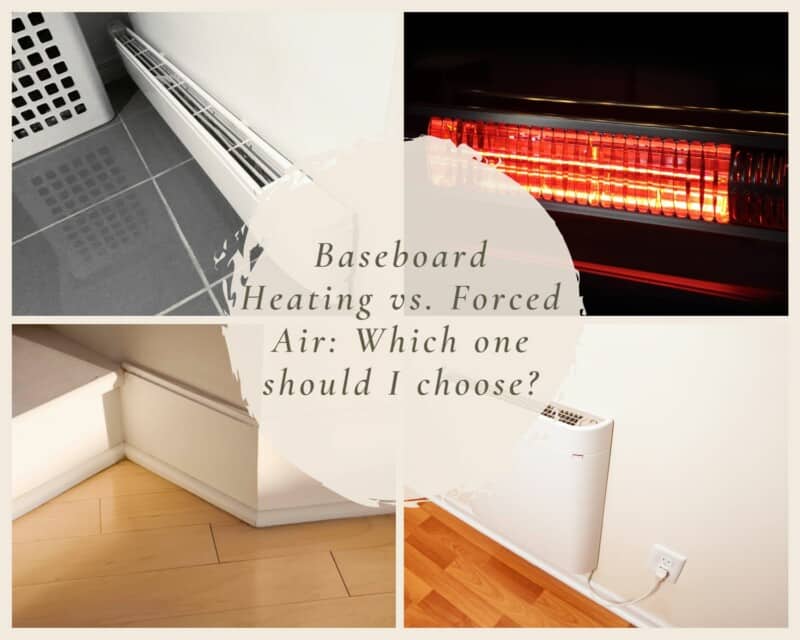The choice between baseboard heating and forced air can be confusing if you’re looking to heat your home. In this article, we’ll explain the differences between these two systems so that you can decide which one is right for your home.
What is Baseboard Heating?
Baseboard heating is an excellent option if you want to save money on your energy bills. They typically work by spreading hot water through pipes that connect the furnace to the rooms. The heated water travels through these pipes until it reaches room temperature in less than an hour. This means there’s no need for ductwork or other costly construction when installing baseboard heaters.
What Is Forced Air?
Forced air is a system of conveying air from a source to a receptacle. It is used in heating and cooling systems, ventilation and air conditioning equipment, refrigeration, and chiller systems. Air is conveyed through ducts or pipes, which can be vertical or horizontal.
The primary purpose of forced air systems is to deliver clean, dry-conditioned air to an occupied space. The amount of air produced depends on the type of system used.
What’s the Difference Between Baseboard and Central Forced Air Heat?
Baseboard heaters are installed in a specific location and deliver heat to that area. They can be used in small rooms, such as bathrooms or closets. They are usually more efficient than forced air systems for larger spaces like bedrooms and kitchens.
A central forced air heating system is distributed through ductwork throughout your house. It consists of an exhaust fan located outside at the top level of your home that sucks in fresh cold air from outdoors. It then pumps it into each room through vents at floor level; this keeps warm or cool air circulating throughout all parts of your home.
What are the Pros of Baseboard Heaters
1. It’s Quiet
Baseboard heaters are very quiet. If you’re worried about noise, baseboard heaters are your best bet. They won’t make a sound like forced air, which can annoy some people.
2. Simple Installation
You may wonder if you can install your baseboard heaters and save money. Yes, you can! Baseboard heaters are easy to install yourself, and many DIY tutorials on YouTube show you how to do it.
3. Secondary Source of Heat
If you have baseboard heat, it’s important to note that it is not a replacement for your furnace. Instead, the heat from your baseboards will be a backup for the furnace when power is out or low. You can also use it to heat water in the wintertime by wiring them up directly with a thermostat.

What are the Cons of Baseboard Heaters
Cost
Baseboard heat can be significantly more expensive than forced air. It is also more challenging to install and maintain, which adds to the final bill.
Interior Design
You may find it difficult to hide your baseboard heating unit. However, you can use it to create a focal point in your home. Placing the team at the end of a hallway or the top of stairs will help draw attention to where you want guests and visitors to walk. This is especially useful if you have small children who may be afraid of heights or are unsteady on their feet.
Safety Hazard
Baseboard heaters are not a good choice for homes with children. They can be a fire hazard and dangerous to small children and pets. Baseboard heaters are also more likely to cause burns than forced air heaters.
Dry Heat
Baseboard heaters are also known as “dry heat” systems. They produce radiant heat, which means they use electricity to heat the room and distribute it evenly throughout your home. Dry-only baseboards are generally more efficient than forced air systems because they don’t require heating or cooling ducts or fans.
Require Regular Cleaning
If you want to keep your baseboard heaters in good condition, it’s essential to clean them regularly. This is especially true if you live in an area with dust and dirt. The best way to do this is by vacuuming the radiators once every few months. You can also use a gentle cleaner on the inside of the heater, like vinegar, if there are stains.
What are the Pros of Forced Air Heating
Cost-Effective
Forced Air heating is less expensive to install. However, they also require more maintenance and repair than forced air systems. Baseboard heating systems are more costly to operate over their lifetime. This is because they need the energy to maintain the temperature of the room in which they’re installed. In contrast, forced air furnaces have no such demands placed on them.
Reliability
In the long run, forced air heaters are less reliable than baseboards. This is because baseboards can be unreliable in several ways:
- They can become frozen and fail to work correctly. If your home’s heating source is electric and not gas or oil, there will also be a risk of electric short circuits if it gets too cold outside.
- Baseboard heaters tend to clog easily over time due to mineral deposits forming inside them. These deposits often cause failure by causing hard water deposits in pipes near vents.
What are the Cons of Forced Air Heating
Potential Health Risks
Forced air heating has potential health risks in cleaning dust from ducts and ventilators. This can cause irritation or allergies in some people, especially if they already suffer from asthma or allergies.
The biggest con of forced air heating is the risk of carbon monoxide poisoning. If your heater is not installed correctly and maintained, it could leak carbon monoxide into your home. This can be deadly if you have an improperly ventilated sleeping area or a child sleeps in the room with the heater running.
Noise
One of the most significant differences between a baseboard and forced air is noise. While both systems will make noises as they heat your home, baseboard heating systems tend to be louder than their forced-air counterparts. This can be distracting if you’re trying to sleep when they kick in or just want to watch TV in peace.
Which is Better for Your Budget, Baseboard or Forced Air Heating?
Baseboard heating is more expensive than forced air. However, it’s also more efficient and flexible. With a forced-air system, your home will stay warm without gas or oil bills that can be costly. Plus, they have an easy-to-use thermostat that allows you to set specific temperatures for every room in your house.
How to Convert Baseboard Heaters to Forced Air
If you’re interested in converting your baseboard heat to forced air, there are several steps that you must take. First, call a professional to install the system. Baseboards are small and often don’t have the space for extra components like ducts. This means that if you want them to work correctly, they need a particular setup for them all to work together smoothly and efficiently.
Second, cost-wise, installing a forced air unit will be more expensive than simply replacing your existing baseboard heater. It may also depend on where you live and how old your current system is. This helps you end up saving money overall by choosing this option instead!
Conclusion
While the differences outlined above may seem small, they can have a significant impact depending on your unique remodeling needs. Of course, each case will be different, and your choice of heating depends entirely on what is best for you. One thing is sure: both have pros and cons, and it is up to you to decide which works better for your own house.



